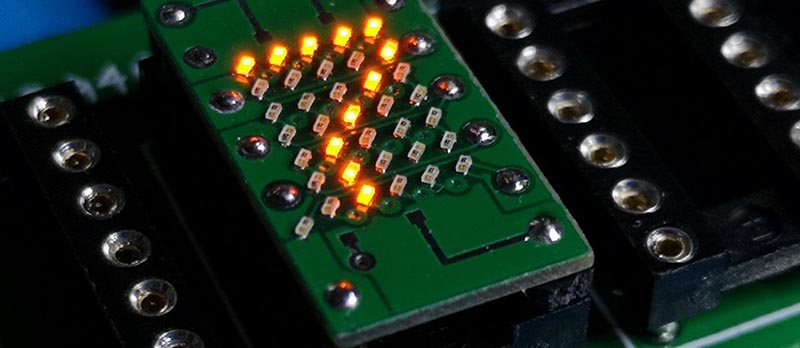In 1971, Texas Instruments released something no one else had ever seen before. The TIL305 was an alphanumeric display, powered by LEDs. Sure, the technology of the early 70s meant the LEDs weren’t very bright, and the displays were expensive, but if you want a display that’s simply classic, and relatively low-power, you won’t be able to do better than a vintage alphanumeric LED display.
As you would expect, new old stock TIL305s are still pricey, and now everybody has access to cheap PCB manufacturing capabilities and really small LEDs. The DIYTIL305 is an attempt to replicate the vintage stuff, and it looks great.
The vintage, TI-made TIL305 is a printed circuit board that clips into a DIP-14 socket. The LED array is 5×7 pixels, with an extra dot for a decimal point, set on a 0.05″ grid, and a translucent red diffuser. A PCB is easy, and with 0201 LEDs you can get the LED pitch you need. Turning a PCB into a DIP-14 only requires a few machine pin headers, and for the diffuser, this project is using laser cut cast acrylic. It’s simple if you have a pick and place machine or a steady hand, and assembly is a snap.
The final DIYTIL305 boards are being tested right now, but so far the results are great. With the right code on a microcontroller, these displays will blink through the digits 0 through 9, and the alphabet is just a little more code. Since this project is using 0201 LEDs, it also means green, white, blue, orange, and yellow displays are possible, something no one could have dreamed of in 1971.
















Feels like winning the lottery.
Have a ton of these TIL305’s waiting for the future. Seems like it is here and I forgot to notice.
Beautiful! Nice work.
The thumbnail on the top page shows blue led white the article image show orange. Its this another blue dress gold dress thing or are they different images?
In the article it says he (she?) built six displays, and used a different LED color in each one.
Could make cast resin diffusers and make any color and density he wants. Could even make a mold that holds the assembled PCBs to cast the resin directly onto them.
I remember thinking of the seemingly endless uses for the 311 back in the 70’s.
As a sufferer of magpie syndrome it will be a lot of years before I need to make or buy any of those things. :)
I had a whole hatch of TILs I threw away a couple of years ago. Lesson: don’t clean up.
In the meantime you can buy Liteon LTP-305 for $3.50.
I recall the TIL305s, think I still have some in an old piece of instrumentation. Don’t mean to pick, but there were NO blue LED displays in the 70s.
I think that is why Brian said:
“…it also means green, white, blue, orange, and yellow displays are possible, something no one could have dreamed of in 1971.”
If there were blue LED’s in the 70’s LASER discs and their players would have been a lot smaller and audio CD’s might not have been a thing at all.
TI had at least 2 other interesting display devices. They had an LED readout with latch and decoder, and another with a decade counter ahead of the latch and decoder.
Pricey, but compact, I could never afford them. The duo meant you could use a faster counter or an up/down counter but still get most of the integration.
So instead of counter/latch/decoder/readout per digit, only the “readout” was needed, explaining higher cost in exchange for less space.
Michael
FWIW, if you need something even smaller, you can use the 3×5 ‘Tom Thumb’ font.